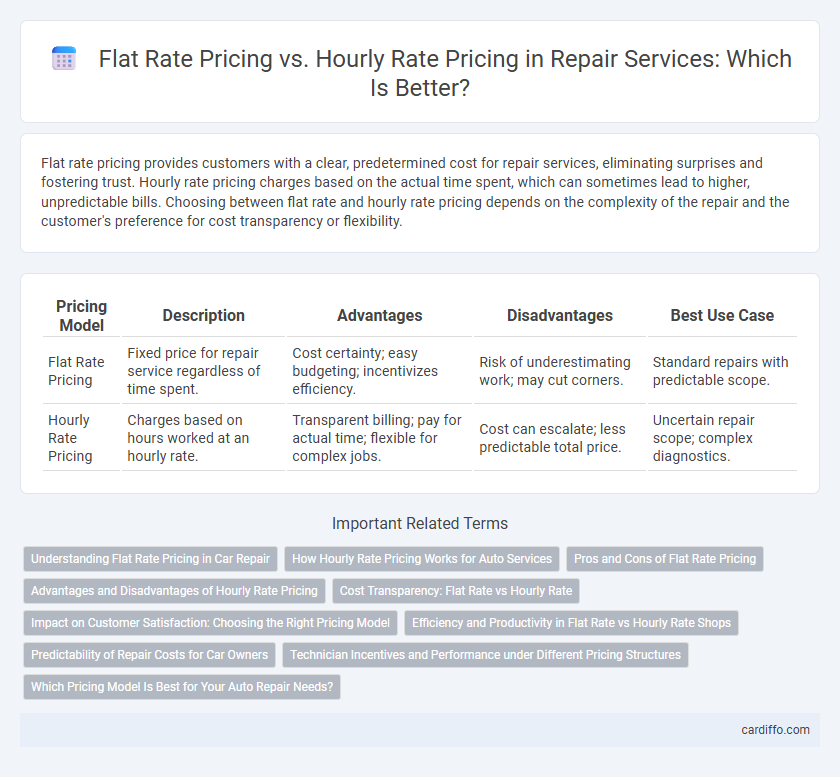Flat rate pricing provides customers with a clear, predetermined cost for repair services, eliminating surprises and fostering trust. Hourly rate pricing charges based on the actual time spent, which can sometimes lead to higher, unpredictable bills. Choosing between flat rate and hourly rate pricing depends on the complexity of the repair and the customer's preference for cost transparency or flexibility.
Table of Comparison
| Pricing Model | Description | Advantages | Disadvantages | Best Use Case |
|---|---|---|---|---|
| Flat Rate Pricing | Fixed price for repair service regardless of time spent. | Cost certainty; easy budgeting; incentivizes efficiency. | Risk of underestimating work; may cut corners. | Standard repairs with predictable scope. |
| Hourly Rate Pricing | Charges based on hours worked at an hourly rate. | Transparent billing; pay for actual time; flexible for complex jobs. | Cost can escalate; less predictable total price. | Uncertain repair scope; complex diagnostics. |
Understanding Flat Rate Pricing in Car Repair
Flat rate pricing in car repair involves charging a fixed price for specific services regardless of the time taken, providing customers with clear cost expectations and simplifying budgeting. This method contrasts with hourly rate pricing, which charges based on labor time, potentially leading to variable final costs depending on repair complexity and technician efficiency. Understanding flat rate pricing helps vehicle owners avoid unexpected expenses and enables repair shops to standardize service charges and improve operational efficiency.
How Hourly Rate Pricing Works for Auto Services
Hourly rate pricing for auto services charges customers based on the exact labor time required to complete repairs, with mechanics logging each task in increments of time. This method allows for precise billing when repair durations are unpredictable or vary significantly due to diagnostic complexities or unexpected issues. Customers pay only for the actual work performed, making it a transparent option for repairs involving multiple or uncertain tasks.
Pros and Cons of Flat Rate Pricing
Flat rate pricing in repairs offers clear cost predictability, enhancing customer satisfaction by eliminating surprise fees and promoting transparency. This model incentivizes technicians to work efficiently, potentially reducing overall service time and labor costs. However, it may lead to underestimating complex issues, causing potential losses for service providers and limiting flexibility for unforeseen repair complications.
Advantages and Disadvantages of Hourly Rate Pricing
Hourly rate pricing provides flexibility by charging customers only for the actual time spent on repairs, making it transparent and fair for varied job complexities. The disadvantage is the potential for unpredictable costs, which can lead to customer dissatisfaction and budgeting challenges. This model may also incentivize longer repair times, impacting overall efficiency and trust.
Cost Transparency: Flat Rate vs Hourly Rate
Flat rate pricing offers clear cost transparency by providing customers with a predetermined, fixed price for repair services, eliminating unexpected charges and enhancing budget predictability. Hourly rate pricing can lead to variable costs based on the time taken, making it harder for customers to anticipate the final bill. Choosing flat rate pricing simplifies financial planning and builds trust by minimizing billing uncertainties in repair projects.
Impact on Customer Satisfaction: Choosing the Right Pricing Model
Flat rate pricing enhances customer satisfaction by providing clear, upfront costs and eliminating billing surprises, which builds trust and confidence. Hourly rate pricing may lead to uncertainty and frustration due to variable costs and longer repair times, negatively impacting the customer experience. Selecting the appropriate pricing model depends on transparency and predictability, crucial factors that influence customer loyalty in repair services.
Efficiency and Productivity in Flat Rate vs Hourly Rate Shops
Flat rate pricing enhances efficiency by standardizing repair times, enabling technicians to complete tasks faster without the pressure of time tracking, which often boosts overall productivity in flat rate shops. Hourly rate pricing may lead to lower productivity as technicians might feel incentivized to extend repair durations to increase billable hours, causing potential inefficiencies. Data from automotive repair centers indicate that flat rate shops achieve up to 20% higher throughput compared to hourly rate shops, highlighting the productivity advantages.
Predictability of Repair Costs for Car Owners
Flat rate pricing offers car owners predictability by providing a fixed cost upfront, eliminating surprises during vehicle repairs. Hourly rate pricing can result in variable expenses depending on the labor time required, making budgeting more challenging. Clear cost expectations with flat rate pricing enhance financial planning and reduce stress associated with unexpected repair bills.
Technician Incentives and Performance under Different Pricing Structures
Flat rate pricing motivates technicians to complete repairs efficiently, as their compensation is tied to job completion rather than hours worked, encouraging higher productivity and quality workmanship. Hourly rate pricing may reduce the incentive for speed but can promote thoroughness and attention to detail, as pay increases with time spent on each repair. Balancing these pricing structures influences technician performance, with flat rates driving efficiency and hourly rates fostering meticulous repair work.
Which Pricing Model Is Best for Your Auto Repair Needs?
Flat rate pricing offers transparency and predictability by charging a fixed amount for specific auto repair services, making it ideal for straightforward repairs where time estimates are consistent. Hourly rate pricing provides flexibility and may better accommodate complex or unpredictable repairs, as payment corresponds directly to the labor hours involved. Selecting the best model depends on the repair type, with flat rate often preferred for standardized jobs and hourly pricing suited for diagnostics or custom work.
flat rate pricing vs hourly rate pricing Infographic

 cardiffo.com
cardiffo.com